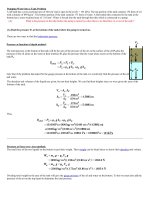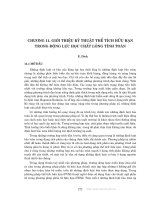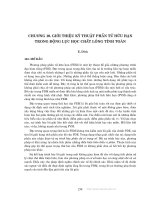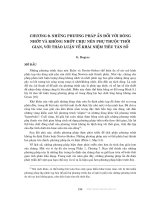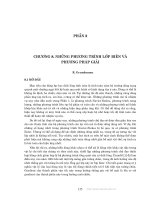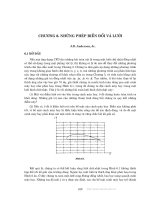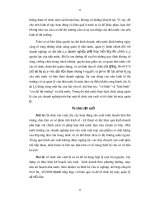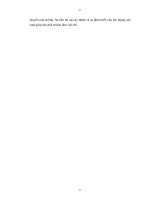Áp dụng lý thuyết thủy tĩnh và động lực học chất lỏng để giải bài toán thực tế
Bạn đang xem bản rút gọn của tài liệu. Xem và tải ngay bản đầy đủ của tài liệu tại đây (130.85 KB, 4 trang )
Pumping Water into a Tank Problem
A tall tank has a cross-sectional area of 340 cm
2
and is open to the air (P
a
= 101 kPa). The top portion of the tank contains 156 liters of oil
with a density of 890 kg/m
3
. The bottom portion of the tank contains 173 liters of water. A horizontal tube connected to the tank at the
bottom has a cross-sectional area of 11.0 mm
2
. Water is forced into the tank through the tube which is connected to a pump.
(A) What is the pressure in the tube before the pump is turned on when there is no fluid flow in or out of the tank ?
(A) Find the pressure P
b
at the bottom of the tank before the pump is turned on.
There are two ways to find the hydrostatic pressure.
Pressure as function of depth method:
The total pressure at the bottom of the tank will be the sum of the pressure of the air on the surface of the oil P
a
plus the
pressure of the oil alone on the water at their interface P
o
plus the pressure that the water alone exerts on the bottom of the
tank P
w
.
Note that if the problem had asked for the gauge pressure at the bottom of the tank we would only find the pressure of the oil
and water.
The densities and volumes of the liquids are given, but not their heights. We can find their heights since we were given the area of the
bottom of the tank.
Thus
Pressure as Force over Area method:
The total force of the two liquids on the bottom is just their weight. Their weight can be found since we know their densities and volume.
Dividing total weight by the area of the tank will give the gauge pressure of the oil and water on the bottom. To this we must also add the
pressure of the air on the top liquid to determine the total pressure.
Pumping Water into a Tank Problem
(B) If the pump pumps 3.80 liter of water through the tube every minute, what is the velocity of the water in the tube ?
(B) Find the velocity of the water in the tube v
t
when water is being pumped into the tank.
Since we are given the volume flow rate and the area of the tube we can find the velocity of the water in the tube using the velocity flow
rate relations.
The only tricky part is to be sure to convert the given flow rate (3.80 liters/minute) and the given area of the tube (11.0 mm
2
) to the same
set of units. Observe that this was the first thing we did when the givens were written down. If fact is a good policy to always convert the
givens into SI units at the start of most problems. This means that you do not have to continually be checking the units and converting
them over and over again.
How would this look if you did not convert the units first.
This is a velocity but it is not in any set of units that are easily reconized. By playing with the units you can see that it is .34545 km/min
but that is still not an SI unit.
Pumping Water into a Tank Problem
(C) What is the pressure of the water in the tube when the water is flowing ?
C) Find pressure in the tube P
t
when water is being pumped into the tank.
Applying Bernoulli's equation to the water in the tube and to the surface of the water at the interface with the oil we get
Here the subscript
s
reference the surface of the water at the interface with the oil. Bernoulli's equation can not be applied across the
interface because it can only be applied to the same liquid at two different points in its flow stream.
Since we have chosen the level of the tube to be the zero reference level for the potential energy, the height of the water in the tube is
zero.
The pressure on the water at the interface on the surface of the water is due to the pressure of the oil above it plus the atmospheric
pressure, .
One approximation we can make to simplify the problem is to note that since the tank is large, the velocity of the surface will be small, v
s
≅ 0 (In part D we will justify this assumption). This means that we can neglect pressure associated with the velocity of the surface,
. Solving for P
t
We have already calculated the first three terms in part A. They represent the pressure when there was no fluid flow, i.e., the hydrostatic
pressure at the bottom of the tank. Using this and the answer we found for the velocity in part B,
We see that when the fluid is flowing, its pressure is reduced from the hydrostatic equilibrium value by the pressure associated with the
flowing liquid in the tube. This seems counter intuitive that the pressure in the tube would drop if the fluid is be forced into the tank
through the tube. Remember that the pressure is not the only thing that is "pushing" the fluid. Once the fluid starts flowing, the fluid's
motion also creates a pressure term. What can be said is that the pressure the pump has to exert to set the fluid in motion and overcome the
hydrostatic pressure is larger.
A mathematical way to understand why the pressure in the tube is less when the water is flowing is to observe that our solution does not
dependent upon the sign of the velocity since the kinetic energy pressure-term depends upon the square of the velocity. This mean we
could imagine that the pipe was not connect to a pump but just open to the air so that the water was flowing out of the tank through the
tube at the same speed. The solution would be almost the same the same. In this case, it is not surprising that pressure drops in the tube
when the water is allowed to flow out the bottom through the tube. In fact, if the tube was open to the air the pressure would drop to that
of the atmospheric pressure when steady-state equilibrium flow is established. We could use this information to determine the velocity of
the fluid-flow in the tube if were open to the air.
(D) What is the rate at which the surface of the oil rises per minute ?
D) Find the velocity of the surface v
s
in cm/min.
Here we can use the equation of continuity (conservation of mass) to compare the flow rate in the tube to that at the surface of the water.
The velocity of the surface of the water will be the same as the velocity of the surface of the oil.
Observe that this small velocity justifies our neglecting it in part C. In fact the pressure associated with the velocity of the surface is very
small.
Givens and Labels:
V
w
= 173 l = .173 m
3
(Volume of the water in the tank.)
V
o
= 156 l = .156 m
3
(Volume of the oil in the tank.)
ρ
w
= 1000 kg/m
3
(Density of the water.)
ρ
o
= 890 kg/m
3
(Density of the oil.)
h
w
= ? (Height of the water in the tank.)
h
o
= ? (Height of the oil in the tank.)
A
T
= 340 cm
2
= .0340 m
2
(Area of the tank.)
A
t
= 11.0 mm
2
= 11.0x10
-6
m
2
(Area of the tube.)
= 3.80 l/min
= 6.3333x10
-5
m
3
/s
(Volume flow rate in the tube.)
P
a
= 101x10
3
Pa (Pressure of the air above the oil.)
